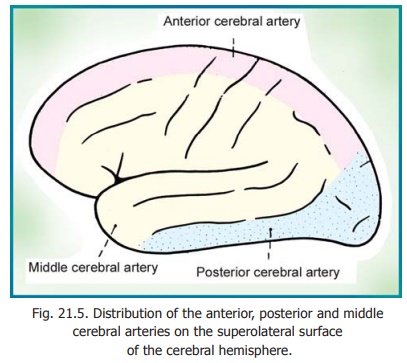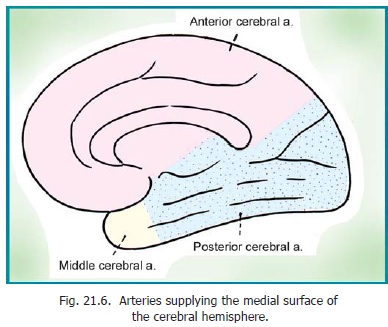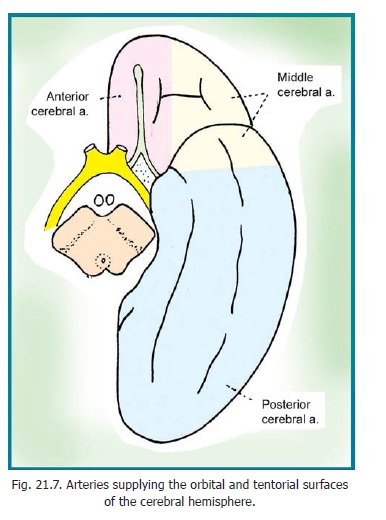Chapter: Human Neuroanatomy(Fundamental and Clinical): Blood Supply of Central Nervous System
Arterial Supply of the Cerebral Cortex - Blood Supply of Central Nervous System

Arterial Supply of the Cerebral Cortex
The cerebral cortex is supplied by cortical branches of the anterior, middle and posterior cerebral arteries.
Superolateral surface
The greater part of the superolateral surface is supplied by the middle cerebral artery (Fig. 21.5). The areas not supplied by this artery are as follows.

(a) A strip half to one inch wide along the superomedial border extending from the frontal pole to the parieto-occipital sulcus is supplied by the anterior cerebral artery.
(b) The area belonging to the occipital lobe is supplied by the posterior cerebral artery.
(c) The inferior temporal gyrus (excluding the part adjoining the temporal pole) is also supplied by the posterior cerebral artery.
Medial surface
The main artery supplying the medial surface is the anterior cerebral (Fig. 21.6). The area of this surface belonging to the occipital lobe is supplied by the posterior cerebral artery.

Inferior Surface
The lateral part of the orbitalsurface is supplied by the middle cerebral artery, and the medial part by the anterior cerebral artery (Fig. 21.7).

The tentorial surface is supplied by the posterior cerebral artery. The temporal pole is, however, supplied by the middle cerebral artery (Fig. 21.7).
Additional points of interest
From the description given above it will be clear that the main somatic motor and sensory areas are supplied by the middle cerebral artery except in their uppermost parts (leg areas) which are supplied by the anterior cerebral. The acoustic area is supplied by the middle cerebral artery, and the visual area by the posterior cerebral.
Clinical:
The part of the visual area responsible for macular vision lies in the region where the territories of supply of the middle and posterior cerebral arteries meet. It may receive a supply from the middle cerebral artery, either directly, or through anastomoses with branches of the posterior cerebral artery. This is one explanation for the observation that macular vision is often spared in cases of thrombosis of the posterior cerebral artery. The phenomenon can also be explained by the observation that dye injected into the carotid system (for angiographic studies) often passes into the posterior cerebral artery through the posterior communicating artery.
The cortical arteries give off branches that run perpendicularly into the substance of the cerebral hemisphere. Some of these are short and end within the grey matter of the cortex. Others are longer and penetrate into the subjacent white matter. While cortical branches may anastomose with each other on the surface of the brain, the perpendicular branches (both long and short) behave as terminal or end arteries. Each branchsupplies a limited area of brain tissue, and does not anastomose with neighbouring arteries. As a result, blockage of such a branch leads to death (necrosis) of brain tissue in the region of supply.
Having studied the blood supply of the cerebral hemispheres we can now understand the effects of interruption of blood flow through major arteries.
1. Thrombosis in the main stem ofthe anterior cerebral artery
(beyondthe anterior communicating artery) leads to the following.
(a) Paralysis (or weakness) of muscles of the leg and foot of the opposite side (by involvement of the upper part of the motor area).
(b) Loss (or dulling) of sensations from the leg and foot of the opposite side (by involvement of the upper part of the sensory area).
(c) Sense of stereognosis is impaired (by involvement of parietal lobe).
(d) Personality changes (by involve-ment of frontal lobe).
2. Thrombosis in the main stem of the middle cerebral artery
(a) Hemiplegia and loss of sensations on the opposite half of the body. The face and arms are most affected. Foot and leg are spared.
(b) Aphasia (by involvement of Broca’s and Wernicke’s areas), specially if the thrombosis is in the left hemisphere in a right handed person.
(c) Homonymous hemianopia on opposite side (by involvement of optic radiation).
(d) Hearing may be affected but this may be compensated by the opposite hemisphere.
3. Thrombosis in the main stem of the posterior cerebral artery leads mainly to visual effects. There is homonymous hemianopia on the opposite side. For reasons explained above, above the macular area is often spared.
Related Topics